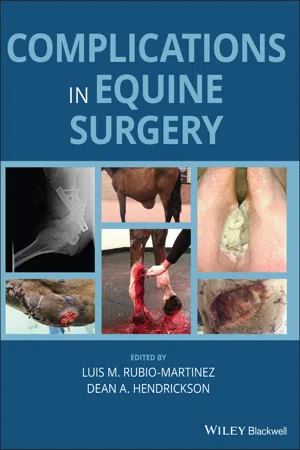
- English
- ePUB (mobile friendly)
- Available on iOS & Android
Complications in Equine Surgery
About This Book
Complications in Equine Surgery is the first reference to focus exclusively on understanding, preventing, recognizing, managing, and prognosing, technical and post-procedural complications in equine surgery. Edited by two noted experts on the topic, the book presents evidence-based information using a clear approach, organized by body system. Featuring color images, the book contains detailed coverage of the gastrointestinal, respiratory, musculoskeletal, urogenital, and neurological systems.
Each chapter contains a short introduction of the procedure with explanations of when and how the procedure is to be performed. All chapters review how to recognize and prevent technical complications and explain how to manage post-operative complications. This important text:
- Offers the first resource specifically focused on complications encountered in equine surgery
- Takes a helpful format organized by body system
- Provides consistently formatted chapters for ease of use
- Covers clinically relevant information for dealing with technical and post-operative complications
- Presents more than 350 color images to illustrate the concepts described
Written for general practitioners and specialists, Complications in Equine Surgery is an essential resource to decreasing morbidity and mortality and increasing surgical success in horses.
Frequently asked questions
Information
1
Surgical Complications
Overview
List of Complications Associated with Surgery:
- Morbidity and mortality
- Surgical checklists
- Perioperative consequences of surgical trauma
- Metabolic and nutritional effects
- Neuroendocrine
- Systemic inflammatory response
- Pain
- Impact of host factors and comorbid conditions
- Minimize errors by applying an appropriate surgical technique.
- Identify and manage errors in a timely manner and in a way that would prevent ensuing complications.
- Identify and manage complications in a timely manner and appropriately.
- Identify and consider patient‐related complications in the decision‐making process, so that they can be anticipated, prevented or managed correctly.
Morbidity and Mortality
Table of contents
- Cover
- Table of Contents
- Title Page
- Copyright Page
- Dedication Page
- Foreword
- Preface
- Acknowledgements
- List of Contributors
- 1 Surgical Complications
- 2 Complications of Parenteral Administration of Drugs
- 3 Complications of Intravascular Injection and Catheterization
- 4 Complications of Endoscopy
- 5 Complications of Nasogastric Intubation
- 6 Complications of Fluid Therapy
- 7 Complications Associated with Hemorrhage
- 8 Complications of Blood Transfusion
- 9 Complications Associated with Sutures
- 10 Complications of Bone Graft Harvesting, Handling, and Implantation
- 11 Complications of Cryosurgery
- 12 Complications of Laser Surgery
- 13 Complications of Systemic Analgesic Drugs
- 14 Complications of Loco‐Regional Anesthesia
- 15 Complications of Sedative and Anesthesia Medications
- 16 Complications During Recovery from General Anesthesia
- 17 Complications Associated with Surgical Site Infections
- 18 Complications of Reconstructive Surgery
- 19 Complications of Excessive Granulation Tissue
- 20 Complications of Skin Neoplasia
- 21 Complications of Skin Grafting
- 22 Complications of Oral and Salivary Gland Surgery
- 23 Complications of Esophageal Surgery
- 24 Complications of Stomach Surgery
- 25 Complications of Splenic Surgery
- 26 Complications of Abdominal Approaches
- 27 Complications of the Intraoperative Colic Patient
- 28 Complications of the Postoperative Colic Patient
- 29 Complications of Surgery of the Rectum and Anus
- 30 Complications of Abdominal Surgery: Incisional Hernia
- 31 Complications of Equine Laparoscopy
- 32 Complications of Endoscopic Laser Surgery
- 33 Complications Following Surgery of the Equine Nasal Passages and Paranasal Sinuses
- 34 Complications in Pharynx Surgery
- 35 Complications in Larynx Surgery
- 36 Complications of Surgery for Diseases of the Guttural Pouch
- 37 Complications of Equine Tracheal Surgery
- 38 Complications of Equine Thoracic Surgery
- 39 Complications of Testicular Surgery
- 40 Complications of Penile and Preputial Surgery
- 41 Complications of Ovarian and Uterine Surgery
- 42 Complications of Vulvar, Vestibular, Vaginal, and Cervical Surgery
- 43 Complications of Urinary Surgery
- 44 Complications of Diagnostic Tests for Lameness
- 45 Complications of Synovial Endoscopic Surgery (Arthroscopy, Tenoscopy, Bursoscopy)
- 46 Complications of Equine Orthopedic Surgery
- 47 Complications of Surgery of the Equine Foot
- 48 Complications of Surgical Correction of Angular Limb Deformities
- 49 Complications of Surgical Correction of Flexural Limb Deformities
- 50 Complications of Splint Bone Fractures
- 51 Complications of Craniomaxillary and Mandible Fractures
- 52 Complications of Tendon Surgery
- 53 Complications of Muscle Surgery
- 54 Complications of Regenerative Medicine
- 55 Complications of Osseous Cyst‐Like Lesions
- 56 Complications of Equine Ophthalmic Surgery
- 57 Complications of Diagnostic Procedures of the Nervous System
- 58 Complications of Anterior Cervical Fusion
- 59 Complications of Surgery for Impingement of Dorsal Spinous Processes
- 60 Complications of Peripheral Nerve Surgery
- Index
- End User License Agreement